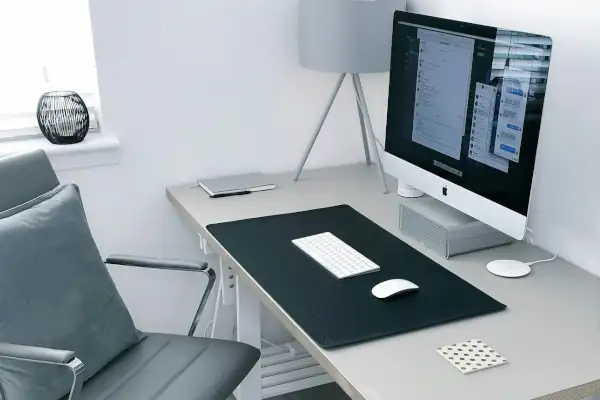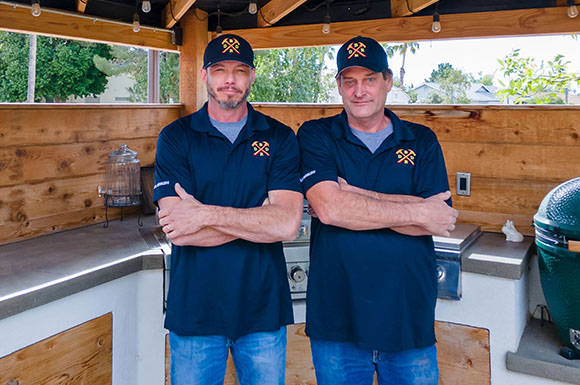Are you considering a kitchen remodel and seeking fresh design inspiration? Look no further! In this blog post, we’ll delve into five captivating kitchen designs that will take your space to new heights. Whether you’re drawn to the timeless elegance of a traditional kitchen, the sleek minimalism of a modern design, the inviting charm of a rustic farmhouse aesthetic, the urban edge of an industrial look, or the harmonious fusion of old and new in a transitional design, we’ve got you covered. Each style possesses its unique character, and we’ll explore the defining elements that set them apart. Prepare to discover your ideal kitchen design and envision the transformation of your culinary haven.
Table of Contents
1. Modern/Contemporary Kitchens

The History of Modern Kitchens
Modern and contemporary kitchen designs trace their origins to the early to mid-20th century, influenced by the Modernist and Bauhaus movements. These design philosophies prioritized simplicity, functionality, and innovative materials. The concept of a “modern kitchen” took shape as kitchens evolved from utilitarian spaces into integrated and stylish areas within homes.
Kitchens began to feature streamlined cabinetry, integrated appliances, and efficient layouts. Following World War II, suburban housing boomed, and the open-plan kitchen became a hallmark of modern living, emphasizing a connection between cooking and communal spaces.
Design Characteristics of Modern Kitchens
A modern/contemporary kitchen embodies elegance and simplicity. It values clean, organized lines and practicality above all else. The design strives to create an open and welcoming space where every element serves a purpose without unnecessary frills. In modern kitchens, form seamlessly blends with function, resulting in a practical yet aesthetically pleasing environment. The overall vibe is one of sleekness and minimalism, fostering a serene and well-organized atmosphere.
Cabinetry
Countertops
Appliances
Backsplash
Lighting
Island
What sort of materials are included in Modern kitchen designs?
Materials like stainless steel, glass, and concrete define the sleek look of modern kitchens. Cabinetry features flat-panel designs with concealed hardware, while durable and easy-to-maintain materials such as quartz or polished natural stone grace the countertops, often in neutral colors. This material selection ensures both a luxurious appearance and functional efficiency, creating a seamless fusion of sophistication and practicality.
Try to make use of:
- Stainless steel
- Glass
- Concrete
- Quartz/stone
2. Traditional Kitchens
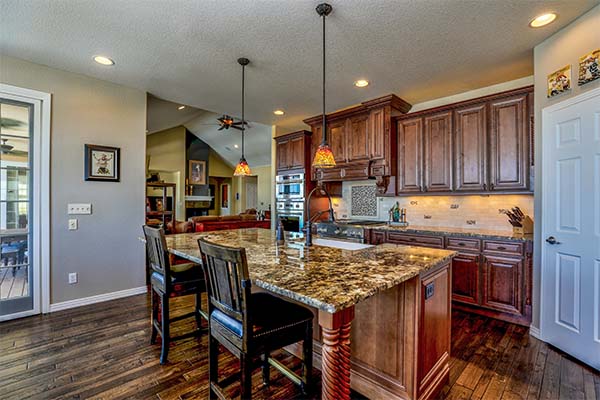
The History of Traditional Kitchens
Traditional kitchen design has its roots in historical architectural and design styles that span centuries. Influences come from classical architectural designs and the desire to create spaces that reflect a sense of heritage and time-honored values.
Throughout history, craftsmanship and attention to detail were highly valued, resulting in cabinetry featuring raised panels, decorative molding, and ornate hardware. Traditional kitchens pay homage to these timeless design principles, allowing homeowners to experience the enduring charm and comfort of the past while enjoying modern functionality.
Design Characteristics of Traditional Kitchens
A traditional kitchen exudes timeless elegance and a sense of warmth. It embraces classic design elements that emphasize intricate details and rich, inviting aesthetics. In a traditional kitchen, the focus is on creating a cozy and familiar space that evokes a sense of comfort and tradition. Elements of form and function harmoniously coexist to ensure a practical yet visually pleasing environment. The overall ambiance radiates with a sense of heritage and the comfort of well-organized familiarity.
Cabinetry
Countertops
Appliances
Backsplash
Lighting
Island
What sort of materials are included in Traditional kitchen designs?
Traditional kitchens incorporate a variety of high-quality materials that enhance their classic appeal. Wood, often in rich and warm tones like cherry, oak, or mahogany, is a prominent choice for cabinetry. Countertops may feature natural stone, such as granite or marble, or classic materials like butcher block. These materials are selected not only for their durability but also for their ability to impart a sense of tradition and timelessness to the space.
- Stainless steel
- Wood (Cherry, Oak, Mahogany)
- Natural Stone (Granite, Marble)
- Butcher Block
3. Rustic/Farmhouse Kitchens
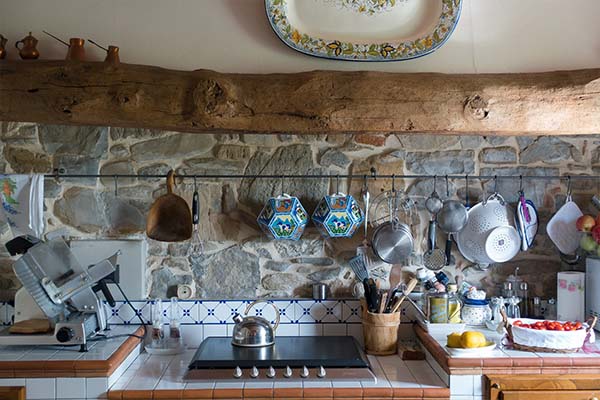
The History of Rustic/Farmhouse Kitchens
The rustic/farmhouse kitchen design draws inspiration from the simplicity and practicality of country life. Historically, farmhouses were designed for functionality, with kitchens serving as the heart of the home. Over time, this utilitarian style evolved into a design aesthetic that values authenticity and a connection to the past.
Design Characteristics of Farmhouse Kitchens
A rustic/farmhouse kitchen is a celebration of authenticity and charm. It encapsulates the warm and inviting ambiance of a countryside cottage while embracing the beauty of natural materials and vintage aesthetics. In a rustic/farmhouse kitchen, the emphasis is on creating a cozy and down-to-earth space that feels like home. Every element is chosen for its ability to evoke a sense of rustic simplicity and wholesome comfort. The overall atmosphere exudes a sense of casual elegance, creating a space where everyone feels welcome.
Cabinetry
Countertops
Appliances
Backsplash
Lighting
Island
What Sort of Materials Are Included in Rustic/Farmhouse Kitchen designs?
Rustic/farmhouse kitchens feature materials that reflect the rugged beauty of nature and the charm of rural living. Wood is a dominant element, often with a distressed or reclaimed look, lending a weathered and well-loved appearance to cabinetry. Butcher block or wood countertops add warmth and character. The use of natural stone for backsplashes or farmhouse sinks enhances the rustic aesthetic. Vintage-inspired accessories, such as mason jar lighting fixtures or farmhouse-style faucets, further accentuate the cozy and nostalgic vibe.
- Wood (Distressed or Reclaimed)
- Natural Stone
- Butcher Block
- Vintage-Inspired Accessories
4. Industrial Kitchens
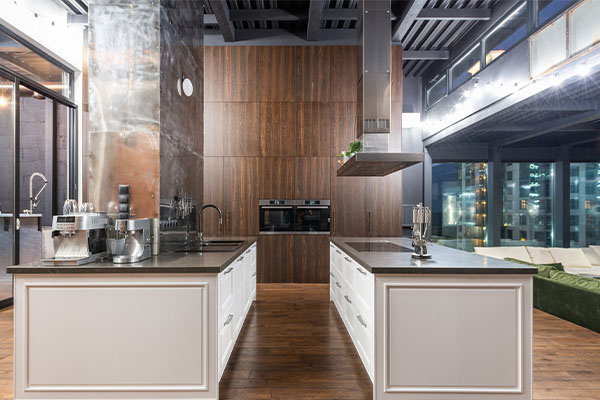
History of Industrial Style Kitchens
Industrial kitchen design draws inspiration from the utilitarian aesthetics of urban spaces, particularly warehouses and factories. During the 20th century, as urbanization grew, repurposing old industrial spaces into living areas became a trend, and this included incorporating industrial design elements into home interiors.
The concept of an “industrial kitchen” evolved from this trend, emphasizing the use of raw materials, open layouts, and practicality.
Design Characteristics of Industrial Kitchens
An industrial kitchen is a nod to the raw, edgy aesthetics of urban warehouses and factories. It embraces the rugged beauty of exposed materials and the functionality of industrial equipment while maintaining a distinct sense of modernity. In an industrial kitchen, the focus is on creating a space that is both utilitarian and visually striking. Every element is chosen for its ability to evoke an industrial aesthetic while providing practicality and durability. The overall atmosphere exudes an urban, no-nonsense vibe, resulting in a kitchen that is efficient, stylish, and full of character.
Cabinetry
Countertops
Appliances
Backsplash
Lighting
Island
What Sort of Materials Are Included in Industrial Kitchen designs?
Industrial kitchens feature materials that reflect the gritty charm of urban spaces and the durability needed for a bustling kitchen environment. Exposed brick or concrete walls, often left unfinished, add an industrial edge to the backdrop. Cabinetry is typically simple, with flat-panel, matte-finished designs in dark colors or muted tones. Countertops may be made of stainless steel for a sleek and industrial look. The use of metal accents, such as industrial-style pendant lights with exposed bulbs and stainless steel appliances, further enhances the industrial vibe.
- Exposed Brick
- Concrete
- Stainless Steel
- Metal Accents
5. Transitional Kitchens
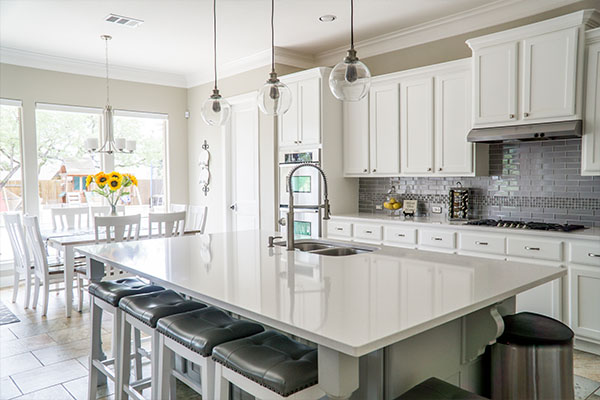
History of Transitional Kitchens
Transitional kitchen design evolved as a response to the desire for a versatile and timeless kitchen aesthetic. It draws inspiration from the need to bridge the gap between traditional and modern design preferences. The concept of a “transitional kitchen” came to prominence in the late 20th century as homeowners sought to create spaces that combined the charm of traditional styles with the functionality of contemporary living.
It provides homeowners with the flexibility to personalize their kitchens while maintaining a cohesive and harmonious look. Today’s transitional kitchens offer a sense of timeless beauty and adaptability, making them a popular choice for those seeking a balanced space.
Design Characteristics of Transitional Kitchens
A transitional kitchen is a beautiful blend of traditional and modern design elements, striking a perfect balance between timeless elegance and contemporary functionality. It embodies a sense of harmony and versatility, creating a space that feels both inviting and up-to-date. In a transitional kitchen, the focus is on creating a flexible and balanced environment where traditional and modern elements coexist seamlessly. Every element is chosen to foster a sense of warmth and sophistication while embracing the practicality of modern living. The overall ambiance appeals to a wide range of tastes, and functions well for all purposes.
Cabinetry
Countertops
Appliances
Backsplash
Lighting
Island
What Sort of Materials Are Included in Transitional Kitchen designs?
Transitional kitchens feature materials that bridge the gap between classic and modern aesthetics, creating a harmonious and versatile design. Cabinetry often combines traditional raised-panel doors with modern flat-panel styles, resulting in a balanced look. Countertops may feature quartz or granite in neutral colors, offering both durability and a touch of elegance. The use of stainless steel appliances and understated hardware adds a modern touch, while neutral color palettes create a serene backdrop. Lighting fixtures typically combine modern and classic elements, such as pendant lights with clean lines and elegant finishes.
- Neutral Color Palettes
- Stainless Steel Appliances
- Quartz or Granite Countertops
As we conclude our exploration of these five captivating kitchen styles, we hope you’ve found inspiration and insights to guide your upcoming remodel. Remember that your kitchen is not just a place for culinary creativity; it’s an expression of your personal style and functionality needs. Whether you opt for the timeless allure of a traditional kitchen, the contemporary elegance of a modern design, the cozy warmth of a rustic farmhouse space, the industrial flair of an urban-inspired look, or the versatile charm of a transitional style, the key is to make it uniquely yours. We wish you a successful and fulfilling kitchen renovation journey, and may your new kitchen become a space where memories are created and cherished for years to come. Happy remodeling!


